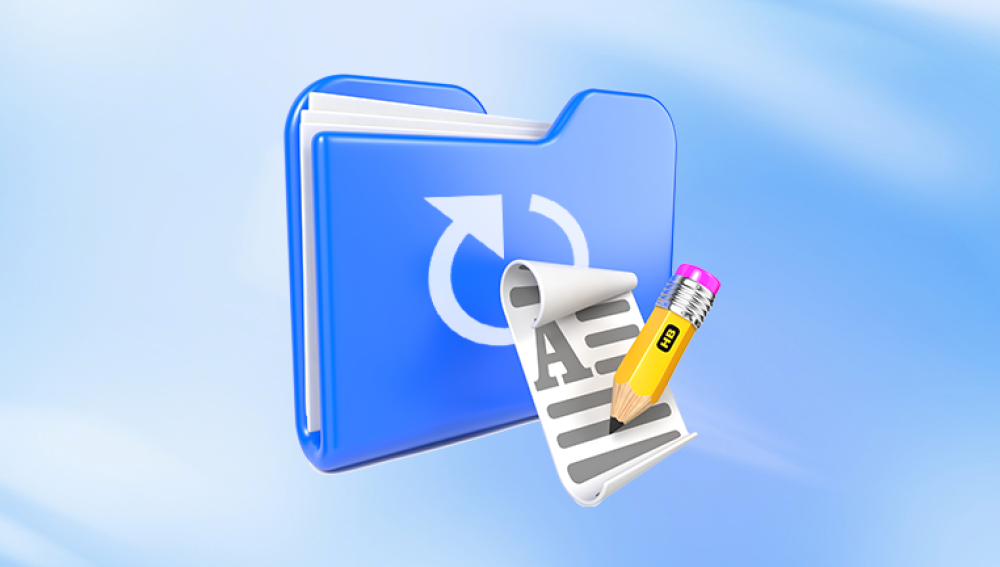When a file is erased in Windows 10. its data isn’t immediately destroyed. Instead, the operating system marks the storage space as available for new data. This means the original content may still exist on the drive until new information overwrites it. That’s why quick action is crucial: the sooner recovery attempts begin, the higher the chances of success.
Step 1: Check the Recycle Bin
For most standard deletions, files are first moved to the Recycle Bin:
Double-click the Recycle Bin icon on the desktop.
Search through the listed files to find the erased one.
Right-click the file and select Restore.
The file will return to its original location.
If the file isn’t in the Recycle Bin, it may have been permanently deleted. Continue with the methods below.

Step 2: Use Windows 10’s File History
If File History was enabled before the file was erased:
Open Settings > Update & Security > Backup.
Click “More options” and select “Restore files from a current backup.”
Browse through available backups, search for the erased file, and click Restore.
Note: File History must have been configured prior to file deletion for this method to work.
Step 3: Restore Previous Versions
Windows 10 keeps track of file and folder versions if System Protection is turned on:
Right-click the folder where the file was located.
Select Properties > Previous Versions tab.
Choose a version before the file was erased.
Click Restore to bring back the earlier version of the folder or file.
Step 4: Check Cloud Services
If you use OneDrive, Google Drive, or Dropbox:
Sign into your account via a web browser.
Check the cloud service’s Recycle Bin or Trash folder.
Restore the erased files from there if available.
Step 5: Recover Using Windows 10 Backup and Restore (Windows 7 Tool)
Though it’s labeled for Windows 7. this tool is still present in Windows 10:
Go to Control Panel > System and Security > Backup and Restore (Windows 7).
Select “Restore my files.”
Follow the wizard to locate and restore files from the available backup.
Step 6: Use Windows File Recovery Tool
Microsoft provides a command-line tool called Windows File Recovery. This utility is free and available from the Microsoft Store.
How to use it:
Download Windows File Recovery from the Microsoft Store.
Open Command Prompt as an administrator.
Use the command:
winfr C: D: /n \path\to\file
Replace C: with the source drive and D: with the destination for recovered files.
This tool supports NTFS, FAT, exFAT, and ReFS file systems.
Step 7: Use Third-Party Data Recovery Software
Drecov Data Recovery
Drecov Data Recovery is a dedicated software tool designed to help Windows 10 users recover erased files quickly and efficiently. Whether files have been removed accidentally, lost after emptying the Recycle Bin, deleted using Shift + Delete, or erased due to formatting or system crashes, Drecov Data Recovery provides a simple and reliable way to retrieve them.
The program works by scanning storage devices such as internal hard drives, SSDs, USB flash drives, and SD cards. Drecov Data Recovery identifies files that still exist on the drive’s storage sectors, even though Windows no longer displays them. It supports recovering a wide range of file types, including photos, videos, documents, emails, and compressed files.
Using Drecov Data Recovery on Windows 10 is straightforward. After downloading and installing the software, users select the drive or device where files were erased, then choose between a quick scan or deep scan depending on how long ago the deletion occurred. Once the scan completes, all recoverable files are displayed in an organized list. The software allows users to preview files before restoring them to a safe location, ensuring only needed items are recovered.
Step 8: Recover Files from an External Backup
If you use external drives or backup services:
Connect your external drive.
Open your backup software (Acronis, Macrium Reflect, etc.).
Browse backup images or snapshots.
Restore erased files selectively.
Step 9: Recovery from USB Drives or SD Cards
Erased files on removable media can be recovered similarly:
Connect the USB or SD card to your computer.
Use data recovery software.
Scan the removable media and restore needed files.
Important: Avoid writing new files to the USB or SD card before recovery, as this could overwrite erased files.
Step 10: Create a System Restore Point or Recover Using System Restore
While System Restore primarily affects system files and settings, it can sometimes help recover data lost due to system issues.
How to use it:
Type “Create a restore point” in the Windows search bar and open it.
Go to System Protection > System Restore.
Select a restore point from before the files were erased.
Follow the prompts to restore system settings and possibly recover files.
Step 11: Use Shadow Copies (If Enabled)
Shadow Copies are hidden backups of files and folders created by Windows:
Open File Explorer.
Navigate to the folder that contained the erased file.
Right-click the folder > Restore previous versions.
Browse and restore the version containing the erased file.
Step 12: Recover Files Using a Linux Live USB (For Advanced Users)
If Windows isn’t booting or files aren’t recoverable through standard methods:
Create a Linux Live USB using Ubuntu or similar.
Boot from the USB stick.
Access Windows partitions through Linux’s file explorer.
Copy important files to an external drive.
Step 13: Consider Professional Data Recovery Services
If:
The drive is physically damaged.
Software cannot detect the drive.
Critical business or legal files are involved.
Professional services may be required. Data recovery labs use hardware tools and cleanroom environments to retrieve data from physically damaged drives.
Factors Affecting Recovery Success
Several elements influence whether erased files can be recovered:
Time elapsed since deletion: The sooner recovery is attempted, the better.
Storage type: SSDs with TRIM enabled may permanently erase data sooner than HDDs.
File system type: NTFS, FAT32. and exFAT have different behaviors regarding deletion.
Drive health: Failing drives reduce recovery chances.
Preventive Measures for the Future
To reduce the risk of future file loss, adopt these best practices:
Regular Backups: Use Windows Backup, OneDrive, or third-party tools.
Cloud Storage: Sync critical files to services like Google Drive or Dropbox.
Recovery Software Installation: Have trusted software installed beforehand.
Use an Antivirus: Protect against ransomware and malware.
How to Avoid Overwriting Erased Files
Stop using the affected drive immediately.
Don’t install software on the same drive.
Save recovered files to a separate drive or USB device.
Free vs. Paid Data Recovery Software
Most tools offer free versions that may limit the amount of data recoverable or advanced features like deep scanning. Paid software typically includes:
Larger or unlimited recovery limits.
Technical support.
More file type support.
File Types Commonly Supported by Recovery Software
Documents: DOCX, XLSX, PPTX, PDF, TXT
Photos: JPG, PNG, GIF, RAW formats
Videos: MP4. AVI, MOV
Audio: MP3. WAV
Compressed files: ZIP, RAR
Understanding Windows 10 File Systems
Knowing your file system helps in choosing the right recovery method:
NTFS: Default Windows 10 file system. Best compatibility with recovery tools.
FAT32/exFAT: Common on USB drives and external devices.
Recovery Process Example Using Recuva
Install Recuva on a USB stick or separate drive.
Open the Recuva Wizard and select file type.
Choose scan location (drive letter).
Run the scan.
Preview files and restore them to a safe location.
Recovery Process Example Using Windows File Recovery
Open PowerShell as administrator.
Run:
winfr C: D: /regular /n *.docx
Replace file types or paths as needed.
Wait for scan to complete and check the destination folder.
SSD Recovery Notes
TRIM on SSDs automatically clears deleted files’ data blocks. This makes recovery software less effective. Specialized SSD recovery services exist but may not guarantee results.
Additional Tips
Monitor storage health with tools like CrystalDiskInfo.
Set up File History as a proactive backup method.
Use cloud-based file versioning features to roll back accidental changes.
Recovering erased files on Windows 10 is entirely possible through a combination of built-in features, third-party software, and professional services. The key is acting quickly and following best practices to avoid overwriting lost data. By understanding the recovery tools available and incorporating regular backup strategies, users can confidently handle file deletion incidents with minimal disruption.




